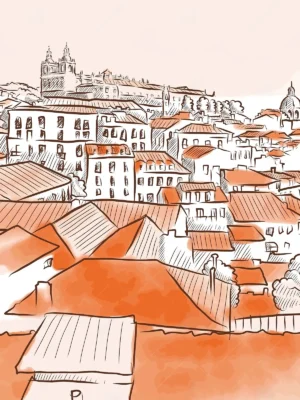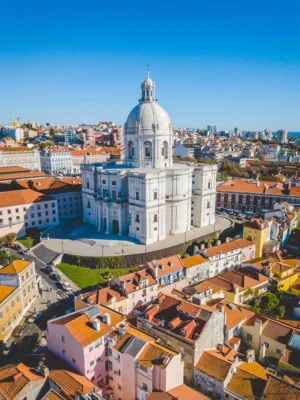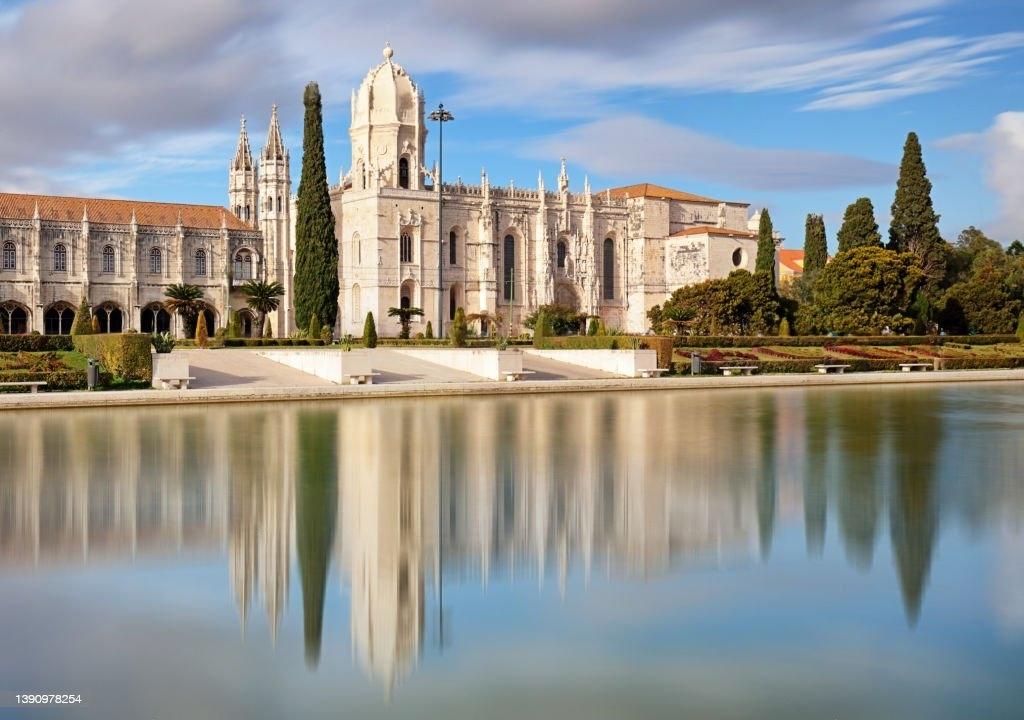



Recommendations for restaurants near Jerónimos Monastery with the highest ratings on Tripadvisor.
- Pão Pão Queijo Queijo: This restaurant is located at Rua de Belem 126 A, 0.2 km from Jerónimos Monastery. It serves Fast Food, Mediterranean, European, and Portuguese cuisine
- Cafetaria do Museu de Marinha: This restaurant is located at Museu de Marinha Praca Imperio Mosteiro dos Jerónimos, 0.2 km from Jerónimos Monastery. It serves Cafe, European, Portuguese, International, and Healthy cuisine
- Choco & Nut Belém: This restaurant is located at Rua dos Jerónimos 14 A, 0.2 km from Jerónimos Monastery. It serves European and Portuguese cuisine
- Mr Wrap: This restaurant is located at Largo dos Jeronimos 4 Belém, 0.2 km from Jerónimos Monastery. It serves International cuisine
Touch each icon to get the information.
How to get there
Do you want to visit the Jerónimos Monastery, one of Lisbon’s architectural gems? Well, don’t worry, I’m going to explain how to get there by bus from Praça do Comércio, the heart of the city. Just follow these simple steps:
1. Head to the bus stop located at the corner of the square, next to the triumphal arch. There, you will see a ticket vending machine where you can purchase a ticket for 2 euros. Alternatively, you can use the Viva Viagem card, which allows you to travel on various modes of transportation at a more affordable price.
2. Wait for bus number 728, which passes by approximately every 15 minutes. Board the bus and validate your ticket or card using the reader located next to the driver. Take a seat and enjoy the urban landscape unfolding before your eyes.
3. Get off the bus at the Belém-Jerónimos stop, which is right in front of the monastery. You have arrived! Now, simply cross the street and admire the impressive façade of the building, combining Gothic and Renaissance elements. Don’t forget to enter and visit the cloister, the church, and the tombs of Vasco da Gama and Luis de Camões, two of Portugal’s national heroes.
4. If you’ve worked up an appetite after so much culture, you can take the opportunity to try the famous Belém pastries, typical sweets filled with cream and sprinkled with cinnamon. You’ll find them in the pastry shop next to the monastery, but be prepared to wait in line as it tends to be quite crowded. I assure you, it’s worth it!
To get to the Jerónimos Monastery by metro from Praça do Comércio and then continue to Cais do Sodré to reach the monastery, you can follow these instructions:
1. From Praça do Comércio, head to the nearest metro station. Walk east along Rua do Arsenal until you reach Terreiro do Paço metro station.
2. At Terreiro do Paço, enter the metro station and purchase a valid ticket for your journey. Make sure you have enough balance on your Viva Viagem card or get an individual ticket.
3. Board the Blue Line (Linha Azul) metro towards Santa Apolónia. Take the metro and continue on this line until Baixa-Chiado station.
4. At Baixa-Chiado, transfer to the Green Line (Linha Verde) metro towards Cais do Sodré. Board the metro and continue until Cais do Sodré station.
5. Once you arrive at Cais do Sodré, you need to exit the station and head towards the train station, which is located within the same transport complex.
6. At Cais do Sodré train station, look for trains on the Cascais line heading to Cascais. Make sure to check the schedules and ensure you board a train that stops at Belém station.
7. Board the train and enjoy the journey to Belém station. This station is close to the Jerónimos Monastery.
8. Once at Belém station, exit and walk west until you reach the Jerónimos Monastery. You will see the impressive structure on your right.
Remember to check the schedules of the Cascais line trains to ensure a convenient connection from Cais do Sodré to Belém. Additionally, keep in mind that these are approximate steps to reach the monastery by metro and train, as there is no direct metro line to the Jerónimos Monastery.

Above in the photo gallery you will find the map in real size.
1. Head to Cais do Sodré station. You can get to this station in several ways:
– Walking from Praça do Comércio: If you are at Praça do Comércio, you can walk to Cais do Sodré station. The station is approximately 1.5 kilometers away, and the walk will take you about 15-20 minutes.
– By metro: If you prefer to use the metro, you can follow the previous instructions to get to Cais do Sodré from Praça do Comércio. Please refer to the earlier instructions on how to get to Cais do Sodré by metro from Praça do Comércio.
– By bus: Similarly, if you prefer to take the bus, you can follow the previous instructions to get to Cais do Sodré from Praça do Comércio. Please refer to the earlier instructions on how to get to Cais do Sodré by bus from Praça do Comércio.
2. Once you are at Cais do Sodré station, check the schedules of the Cascais line trains heading towards Cascais. These trains will take you to Belém, near the Jerónimos Monastery.
3. Board the train heading towards Cascais and enjoy the journey to Belém station. The journey from Cais do Sodré to Belém is short and should take around 10-15 minutes.
4. Upon arrival at Belém station, exit the train and walk towards the west. The Jerónimos Monastery will be a short distance away on your right. You will see the impressive structure in all its splendor.
Remember to check the schedules of the Cascais line trains to ensure convenient connections from Cais do Sodré to Belém. These instructions will help you reach the Jerónimos Monastery using the train as the primary mode of transportation, without the need for the metro or bus on this specific route.
Explore the beauty of the Jerónimos Monastery with ease!
Simply click on the ‘Take me to Jerónimos Monastery’ button below, and it will automatically open the Google Maps application on your mobile device or computer.
The starting location will already be configured, so you just need to follow the step-by-step directions provided by Google Maps. Enjoy a hassle-free stroll as you’re guided through the best routes to reach this iconic monument in Lisbon. Exploring the city couldn’t be easier with the help of Google Maps!”
Please make sure to add the appropriate button on your website with the necessary functionality to open the Google Maps application with the preconfigured location.

Once you arrive at the site, listen to a brief explanation of the history of the place.
- Audio in English
- Audio en français
- Audio en Español
- Audio auf Deutsch





Choose Your Language.
- Reading in English
- Lire en Français
- Lectura en Español
- Lesen auf Deutsch
The Jerónimos Monastery, also known as the Monastery of Santa Maria de Belém, is an impressive monastic complex located in the city of Lisbon, Portugal. Its construction began in 1501 and took place in different stages over several centuries.
The history of the Jerónimos Monastery is closely linked to the discovery of new sea routes and the flourishing of the Portuguese Empire during the Age of Discoveries. The monastery was commissioned by King Manuel I of Portugal in honor of the Order of Saint Jerome and as a symbol of gratitude for the success of Portuguese navigators in their explorations.
The construction of the monastery spanned over a century and a half due to its magnitude and architectural complexity. It was designed in a late Gothic style with Manueline elements, a rich combination of decorative motifs that reflected the exuberance and splendor of the time.
One of the highlights of the Jerónimos Monastery is its church, which is a masterpiece of Manueline style. Its main façade features intricate details, including maritime motifs, royal symbols, and sculptures of saints and prophets. The interior of the church presents a spacious nave and magnificent ribbed vaults.
During the 16th and 17th centuries, the monastery was an important religious and cultural center. In addition to housing the Jerónimos monks, it also became the final resting place for many historical figures, including Vasco da Gama, the famous Portuguese navigator.
In the 19th century, the Jerónimos Monastery suffered severe damage due to the Napoleonic invasions and general neglect. However, in 1860, the Portuguese government undertook its restoration, and in 1907, it was declared a National Monument.
Today, the Jerónimos Monastery is one of the main tourist attractions in Lisbon and has been recognized as a World Heritage Site by UNESCO. Its architectural beauty and historical significance make it a must-visit place to appreciate the grandeur of Portugal’s past.
Le monastère des Jerónimos, également connu sous le nom de monastère de Santa Maria de Belém, est un impressionnant complexe monastique situé dans la ville de Lisbonne, au Portugal. Sa construction a débuté en 1501 et s’est déroulée en différentes étapes sur plusieurs siècles.
L’histoire du monastère des Jerónimos est étroitement liée à la découverte de nouvelles routes maritimes et à l’épanouissement de l’Empire portugais pendant l’ère des Découvertes. Le monastère a été commandé par le roi Manuel Ier du Portugal en l’honneur de l’Ordre de Saint-Jérôme et comme symbole de gratitude pour le succès des navigateurs portugais dans leurs explorations.
La construction du monastère s’est étendue sur plus d’un siècle et demi en raison de sa taille et de sa complexité architecturale. Il a été conçu dans un style gothique tardif avec des éléments manuélin, une riche combinaison de motifs décoratifs qui reflétaient l’exubérance et la splendeur de l’époque.
L’un des points forts du monastère des Jerónimos est son église, qui est un chef-d’œuvre du style manuélin. Sa façade principale présente des détails complexes, notamment des motifs maritimes, des symboles royaux et des sculptures de saints et de prophètes. L’intérieur de l’église présente une nef spacieuse et de magnifiques voûtes nervurées.
Au cours des XVIe et XVIIe siècles, le monastère était un important centre religieux et culturel. En plus d’abriter les moines jéronimiens, il est également devenu le lieu de repos final de nombreuses personnalités historiques, dont Vasco de Gama, le célèbre navigateur portugais.
Au XIXe siècle, le monastère des Jerónimos a subi de graves dommages en raison des invasions napoléoniennes et de l’abandon général. Cependant, en 1860, le gouvernement portugais entreprit sa restauration et en 1907, il fut déclaré monument national.
Aujourd’hui, le monastère des Jerónimos est l’une des principales attractions touristiques de Lisbonne et a été reconnu comme site du patrimoine mondial par l’UNESCO. Sa beauté architecturale et son importance historique en font un lieu incontournable pour apprécier la grandeur du passé portugais.
El Monasterio de los Jerónimos, también conocido como el Monasterio de Santa María de Belém, es un impresionante complejo monástico situado en la ciudad de Lisboa, Portugal. Su construcción comenzó en 1501 y se llevó a cabo en diferentes etapas a lo largo de varios siglos.
La historia del Monasterio de los Jerónimos está estrechamente ligada al descubrimiento de nuevas rutas marítimas y al florecimiento del Imperio Portugués durante la Era de los Descubrimientos. El monasterio fue encargado por el rey Manuel I de Portugal en honor a la Orden de San Jerónimo y como símbolo de agradecimiento por el éxito de los navegantes portugueses en sus exploraciones.
La construcción del monasterio se prolongó durante más de un siglo y medio debido a su magnitud y complejidad arquitectónica. Fue diseñado en estilo gótico tardío con elementos manuelinos, una rica combinación de motivos decorativos que reflejaban la exuberancia y el esplendor de la época.
Uno de los aspectos más destacados del Monasterio de los Jerónimos es su iglesia, que es una obra maestra del estilo manuelino. Su fachada principal cuenta con detalles intrincados, incluyendo motivos marítimos, símbolos reales y esculturas de santos y profetas. El interior de la iglesia presenta una nave espaciosa y magníficas bóvedas de crucería.
Durante los siglos XVI y XVII, el monasterio fue un importante centro religioso y cultural. Además de albergar a los monjes jerónimos, también se convirtió en el lugar de descanso final para muchos personajes históricos, incluyendo a Vasco da Gama, el famoso navegante portugués.
En el siglo XIX, el Monasterio de los Jerónimos sufrió graves daños debido a las invasiones napoleónicas y el abandono general. Sin embargo, en 1860, el gobierno portugués emprendió su restauración y en 1907 fue declarado Monumento Nacional.
Hoy en día, el Monasterio de los Jerónimos es una de las principales atracciones turísticas de Lisboa y ha sido reconocido como Patrimonio de la Humanidad por la UNESCO. Su belleza arquitectónica y su importancia histórica lo convierten en un lugar imprescindible para visitar y apreciar la grandiosidad del pasado portugués.
Das Jerónimos-Kloster, auch bekannt als Kloster Santa Maria de Belém, ist ein beeindruckender Klosterkomplex in der Stadt Lissabon, Portugal. Der Bau begann im Jahr 1501 und erstreckte sich über mehrere Jahrhunderte in verschiedenen Phasen.
Die Geschichte des Jerónimos-Klosters ist eng mit der Entdeckung neuer Seewege und dem Aufstieg des portugiesischen Reiches während des Zeitalters der Entdeckungen verbunden. Das Kloster wurde von König Manuel I. von Portugal in Anerkennung des Ordens des Heiligen Hieronymus und als Dank für den Erfolg der portugiesischen Seefahrer bei ihren Entdeckungsreisen in Auftrag gegeben.
Der Bau des Klosters dauerte über eineinhalb Jahrhunderte aufgrund seiner Größe und architektonischen Komplexität. Es wurde im spätgotischen Stil mit manuelinischen Elementen entworfen, einer reichen Kombination von dekorativen Motiven, die den Überfluss und den Glanz der damaligen Zeit widerspiegelten.
Ein Höhepunkt des Jerónimos-Klosters ist seine Kirche, ein Meisterwerk des manuelinischen Stils. Die Hauptfassade zeichnet sich durch aufwendige Details aus, darunter maritime Motive, königliche Symbole und Skulpturen von Heiligen und Propheten. Der Innenraum der Kirche bietet ein geräumiges Kirchenschiff und prächtige Kreuzrippengewölbe.
Im 16. und 17. Jahrhundert war das Kloster ein bedeutendes religiöses und kulturelles Zentrum. Neben den Jerónimos-Mönchen diente es auch als letzte Ruhestätte vieler historischer Persönlichkeiten, darunter Vasco da Gama, der berühmte portugiesische Seefahrer.
Im 19. Jahrhundert wurde das Jerónimos-Kloster durch die napoleonischen Invasionen und allgemeine Vernachlässigung schwer beschädigt. 1860 wurde es jedoch vom portugiesischen Staat restauriert und 1907 zum Nationaldenkmal erklärt.
Heute zählt das Jerónimos-Kloster zu den wichtigsten Touristenattraktionen in Lissabon und wurde von der UNESCO als Weltkulturerbe anerkannt. Die architektonische Schönheit und historische Bedeutung machen es zu einem Muss, um die Pracht der portugiesischen Vergangenheit zu würdigen.
Closest Nearby Destination: Discover the Next Stop from Here
Cascais: Coastal Charm and Portuguese Treasure
Related products
-

Exploring the Grandeur of Pena National Palace: A Journey into the Heart of Architectural Romanticism
-

Sintra: A Fairytale Escape into Enchanting Palaces and Mystical Landscapes
- Lisboa, Architecture, Castles, Gardens and Parks, Historic Sites, Historical Monuments, Landmarks, Places, Viewpoints
-

View of Lisbon’s Historic Centre: Watercolor Sketch with Hand-Drawn City Illustration
-

The National Pantheon of Lisbon: Exploring Historical and Cultural Grandeur






Reviews
There are no reviews yet.